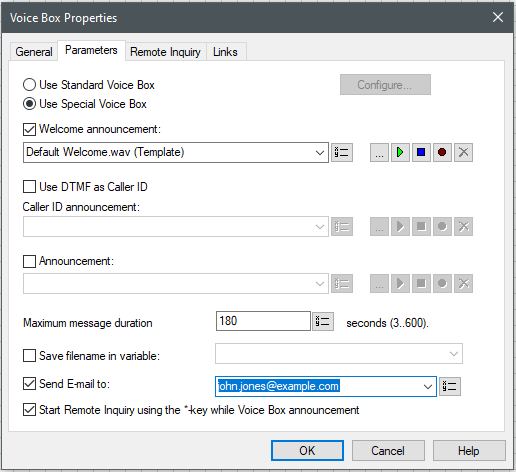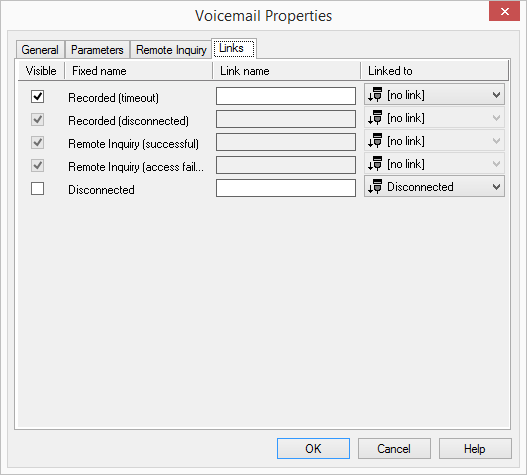2.4.10.11 Voice Box
The Voice Box action connects the caller to your Voice Box:

A welcome announcement can be played first.

You can indicate that the caller’s number should be determined (Caller ID handling).
If the caller's phone number (caller ID) is automatically transmitted, it is stored with the recorded voice message of the caller. You can then return the call using this number.
If no number is transmitted, then you can ask for the number in the following manner: The caller ID announcement will be played. “Please dial the number at which you can be reached. Conclude the entry of the telephone number with the hash button”. All DTMF input entered by the caller up to the hash button (#) will be saved as the caller ID.

You can play another greeting prompting you to leave a voice message. A beep will then automatically be played.

The caller's voice message is recorded. The recording time can be limited (timeout) so that the file with the recorded voice message does not become too large.

Remote inquiry allows you to listen to the voice messages from any telephone line. When calling your SwyxWarenumber, you identify yourself to SwyxWare using your PIN and can then listen to, repeat and, if necessary, delete first the new and then all existing voice messages. In addition, you can change the destination of the Call Forwarding Unconditional or record a new announcement.
The action is terminated

by hanging up while recording the voice message,

by hanging up after a recording of the voice message,

after the Remote Inquiry or

when the Timeout has expired.
Under “Properties”, all three tabs “General”, “Parameters”, "Remote Inquiry" and “Connections” tabs are available for this block.
To set the parameters for the Voice Box
1 Specify whether you want to use your normal Standard Voice Box or whether you want to define a special Voice Box (e.g. with a different announcement) for this action.
If you want to use the standard Voice Box, activate this option. You can still change the Standard Voice Box here. To do so, click on "Configure…".
2 To define the text of the welcome announcement, activate “Welcome announcement”.
You have several options:

From the dropdown list select a file.

Browse your hard drive by clicking on

.
When searching, you can also choose a file in MP3 format. Upon selection, the MP3 file will automatically be converted into the WAV format and saved in the database on the SwyxServer. The converted files are therefore available for use later. During the conversion process, the Info dialog "Please wait, the file is being converted into WAV format" will open.

Click on

, to listen to the selected file. Click on

to stop playing the file.

To record a new announcement, click on

: You will now be prompted to enter a file name. The “Start Recording” window will appear. Click on “Start” to begin recording the announcement. Stop recording by clicking on

.

To delete the selected file, click on

.
| The WAV files, which the administrator has made available to all users, have the extension “(Template)” in the file name. These templates cannot be deleted. |
3 Activate “Use DTMF as Caller ID” in order to ask for the caller’s number if the number was not transmitted.
You can define the announcement as you did for the “Welcome Announcement”.
4 Activate “Announcement” in order to set other announcements (this only makes sense if you have already asked for the caller ID in the previous step
(3)).
You can define the announcement as you did for the “Welcome Announcement”.
5 Enter how long the caller’s message should be recorded (Timeout) in the field “Maximum message length … seconds”.
6 If you would like to save the name of the recorded file in a variable, activate this option and define the variable.
7 In the "Send e-mail to" field, specify to whom the voice message should be sent.
8 Switch on "Start remote inquiry using * key during Voice Box announcement" to listen to your voice messages from another connection or to be able to change your instant forwarding remotely.
9 Move to tab "Standard Remote Inquiry".
10 Define whether you would like to use your normal Standard Remote Inquiry (with or without PIN) or whether you would like to use a special Remote Inquiry for this action (e.g. with a different PIN):

If you would like to use the Standard Remote Inquiry, activate this option. It is still possible to change the Standard Remote Inquiry here. To do so, click on "Configure…".
The "Standard Remote Inquiry" tab will open.

If you would like to configure a special Remote Inquiry, which is only valid for this action, activate the option "Use special Remote Inquiry".
11 Define the PIN (Personal Identification Number) to be used for identification and confirm this here.
Select a five-digit, non-trivial sequence of numbers and confirm it.
| If you configure the Standard Remote Inquiry within a Call Forwarding or system rule, you will always be asked for your user PIN. There is no checkbox for this. If you are calling from your own extension number, for which this Call Forwarding was configured, you will not be asked for your PIN. |
The block "Voice Box" can be seen on the grid surface and is available for further editing.
| If a message without reasonable contents has been recorded (shorter than 3seconds), it will be deleted and not sent. |
Links
On this tab you will find all outputs associated with this block. The outputs are described as follows:
In the first column "Visible", you can define whether each output should be shown in the script window.
| The "Visible" column is only used to define the visibility of the links in the script window. This setting helps to maintain the clarity of the script. You cannot remove outputs, i.e. the connections must be kept, otherwise an error will occur in the script. |
The second column "Default" contains the default name of the output. This provides information about events during the execution of a block so that additional appropriate connections can be created. This fixed name cannot be changed. You can assign your own identifying names to the various contact surfaces in the column "Link name". This name will later appear in the block in the grid interface.
In the last column "Linked to" you see which block input this output is connected to. Here you have the option of selecting a link from a select list, which contains all available blocks.









